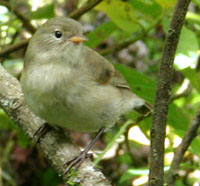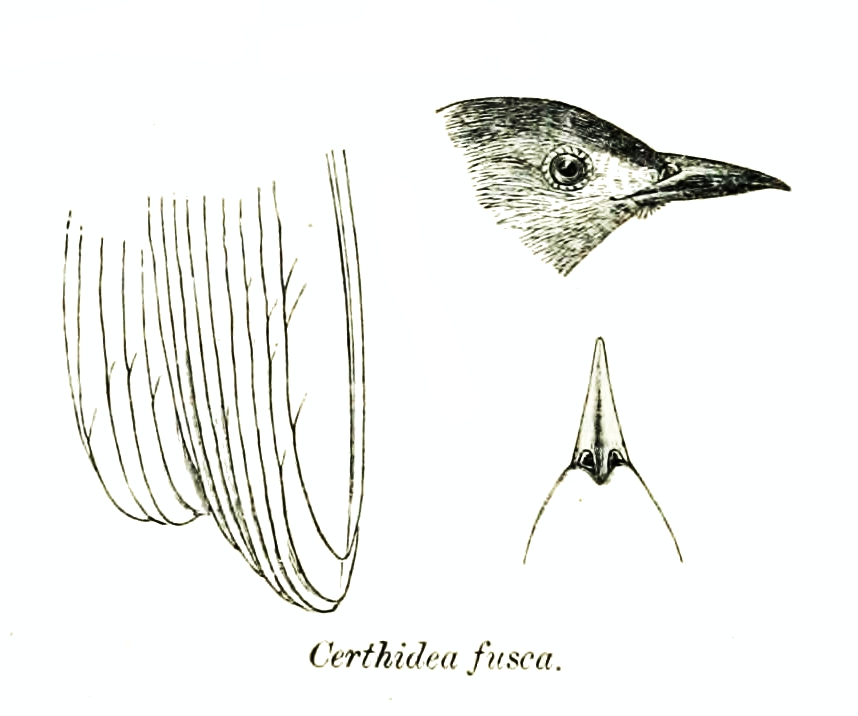|
Certhidea
The warbler-finches are a genus ''Certhidea'' of birds in the tanager family Thraupidae that are endemic to the Galápagos Islands. Together with related genera, they are collectively known as Darwin's finches. The two species were formerly considered to be conspecific; however, they have different songs, prefer different habitats, and are located in different areas on the islands. Taxonomy and species list The genus ''Certhidea'' was introduced in 1837 by the English ornithologist John Gould with the green warbler-finch as the type species. The name is a Latin diminutive of the genus ''Certhia'' introduced by Carl Linnaeus in 1758 for the treecreepers. The members of the genus form part of a group collectively known as Darwin's finches. Although traditionally placed with the buntings and New World sparrows in the family Emberizidae, molecular phylogenetic studies have shown that Darwin's finches are members of the subfamily Coerebinae within the tanager family Thraupidae T ... [...More Info...] [...Related Items...] OR: [Wikipedia] [Google] [Baidu] |
Green Warbler-finch
The green warbler-finch (''Certhidea olivacea'') is a species of bird, one of Darwin's finches in the tanager family Thraupidae. Sometimes classified in the family Emberizidae, more recent studies have shown it to belong in the tanager family. When Darwin collected it in 1835 during the Second voyage of HMS Beagle, ''Beagle'' survey expedition he mistakenly thought it was a wren, but on return to England he was informed in March 1837 by the ornithologist John Gould that the bird was in the group of finches. It is endemic to the Galápagos Islands, Ecuador. This species is closely related to the grey warbler-finch, and the two were formerly considered conspecific, but both species differ in appearance, distribution, habitat, and song. Holding a distinctive place in the evolutionary history of Galápagos finches, phylogenetic studies suggest that the warbler-finches represent one of the earliest branches in the radiation of Galápagos finches, diverging prior to the more well-known ... [...More Info...] [...Related Items...] OR: [Wikipedia] [Google] [Baidu] |
Grey Warbler-finch
The grey warbler-finch (''Certhidea fusca'') is a species of bird, one of Darwin's finches in the tanager family Thraupidae. Sometimes classified in the family Emberizidae, more recent studies have shown it to belong in the tanager family. It is endemic to the Galápagos Islands, Ecuador. This species is closely related to the green warbler-finch, and were formerly considered conspecific, but both species differed in appearance, distribution, habitat, and song. The nominate subspecies is from Pinta and Marchena, ''becki'' from Darwin and Wolf, ''mentalis'' from Genovesa, ''bifasciata'' from Santa Fé, ''cinerascens'' from Española, ''luteola'' from San Cristóbal, and ''ridgwayi'' from Floreana. Grey warbler-finches are found mostly in the shrubland and dry forest of smaller drier islands, and have a suitable coloration for their habitat. Its natural habitats are subtropical or tropical dry forests, subtropical or tropical moist montane forests, and subtropical or trop ... [...More Info...] [...Related Items...] OR: [Wikipedia] [Google] [Baidu] |
Darwin's Finches
Darwin's finches (also known as the Galápagos finches) are a group of about 18 species of passerine birds. They are well known for being a classic example of adaptive radiation and for their remarkable diversity in beak form and function. They are often classified as the subfamily Geospizinae or tribe (biology), tribe Geospizini. They belong to the Thraupidae, tanager Family (biology), family and are not closely related to the true finches. The closest known relative of the Galápagos finches is the South American dull-coloured grassquit (''Asemospiza obscura''). They were first collected when Second voyage of HMS Beagle, the second voyage of the ''Beagle'' visited the Galápagos Islands, with Charles Darwin on board as a gentleman naturalist. Apart from the Cocos finch, which is from Cocos Island, the others are found only on the Galápagos Islands. The term "Darwin's finches" was first applied by Percy Lowe in 1936, and popularised in 1947 by David Lack in his book ''Darwin' ... [...More Info...] [...Related Items...] OR: [Wikipedia] [Google] [Baidu] |
Thraupidae
The tanagers (singular ) comprise the bird family (biology), family Thraupidae, in the order Passeriformes. The family has a Neotropical distribution and is the second-largest family of birds. It represents about 4% of all avian species and 12% of the Neotropical birds. Traditionally, the family contained around 240 species of mostly brightly colored fruit-eating birds. As more of these birds were studied using modern molecular techniques, it became apparent that the traditional families were not monophyletic. ''Euphonia'' and ''Chlorophonia'', which were once considered part of the tanager family, are now treated as members of the Fringillidae, in their own subfamily (Euphoniinae). Likewise, the genera ''Piranga'' (which includes the scarlet tanager, summer tanager, and western tanager), ''Chlorothraupis'', and ''Habia (bird), Habia'' appear to be members of the family Cardinalidae, and have been reassigned to that family by the American Ornithological Society. Description T ... [...More Info...] [...Related Items...] OR: [Wikipedia] [Google] [Baidu] |
Emberizidae
The buntings are a group of Old World passerine birds forming the genus ''Emberiza'', the only genus in the family Emberizidae. The family contains 44 species. They are seed-eating birds with stubby, conical bills. Taxonomy The family Emberizidae was formerly much larger and included the species now placed in the Passerellidae (New World sparrows) and Calcariidae (longspurs and snow buntings). Molecular phylogenetic studies found that the large family consisted of distinct clades that were better treated as separate families. The genus ''Emberiza'' is now the only genus placed in the family Emberizidae. The genus was introduced by the Swedish naturalist Carl Linnaeus in 1758 in the tenth edition of his ''Systema Naturae''. The type species was subsequently designated as the yellowhammer (''Emberiza citrinella''). The genus name ''Emberiza'' is from Old German , a bunting. The origin of the English "bunting" is unknown. A 2008 genetic study found that three emberizid species t ... [...More Info...] [...Related Items...] OR: [Wikipedia] [Google] [Baidu] |
Subfamily
In biological classification, a subfamily (Latin: ', plural ') is an auxiliary (intermediate) taxonomic rank, next below family but more inclusive than genus. Standard nomenclature rules end botanical subfamily names with "-oideae", and zoological subfamily names with "-inae". Detarioideae is an example of a botanical subfamily. Detarioideae is a subdivision of the family Fabaceae (legumes), containing 84 genera. Stevardiinae is an example of a zoological subfamily. Stevardiinae is a large subdivision of the family Characidae, a diverse clade In biology, a clade (), also known as a Monophyly, monophyletic group or natural group, is a group of organisms that is composed of a common ancestor and all of its descendants. Clades are the fundamental unit of cladistics, a modern approach t ... of freshwater fish. See also * International Code of Nomenclature for algae, fungi, and plants * International Code of Zoological Nomenclature * Rank (botany) * Rank (zoolo ... [...More Info...] [...Related Items...] OR: [Wikipedia] [Google] [Baidu] |
Molecular Phylogenetic
Molecular phylogenetics () is the branch of phylogeny that analyzes genetic, hereditary molecular differences, predominantly in DNA sequences, to gain information on an organism's evolutionary relationships. From these analyses, it is possible to determine the processes by which diversity among species has been achieved. The result of a molecular phylogenetic analysis is expressed in a phylogenetic tree. Molecular phylogenetics is one aspect of molecular systematics, a broader term that also includes the use of molecular data in taxonomy and biogeography. Molecular phylogenetics and molecular evolution correlate. Molecular evolution is the process of selective changes (mutations) at a molecular level (genes, proteins, etc.) throughout various branches in the tree of life (evolution). Molecular phylogenetics makes inferences of the evolutionary relationships that arise due to molecular evolution and results in the construction of a phylogenetic tree. History The theoretical fra ... [...More Info...] [...Related Items...] OR: [Wikipedia] [Google] [Baidu] |
Certhia
'' Certhia '' is the genus of birds containing the typical treecreepers, which makes up the family Certhiidae. The typical treecreepers occur in many wooded parts of the North Temperate Zone. They do not normally migrate other than for local movements, such as altitudinal migrations in the Himalayan species. The treecreepers are small woodland birds, very similar in appearance (so they can present serious identification problems where two species occur together). They are brown with streaks above and white below. They have thin pointed down-curved bills, which they use to extricate insects from bark. They have stiff, pointed tail feathers, like woodpeckers and woodcreepers, which they use to support themselves on vertical trees. All the tail feathers but the two central ones are molted in quick succession; the two central ones are not molted till the others grow back, so the bird can always prop itself with its tail. They build cup nests on loose twig platforms wedged behind ... [...More Info...] [...Related Items...] OR: [Wikipedia] [Google] [Baidu] |





